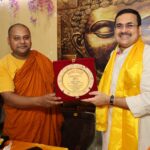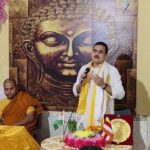SAMVAD: MODI’S VISION OF CIVILISATIONAL DIALOGUE
- By : Anirban Ganguly
- Category : Articles
The Modi-Abe partnership on Samvad looks beyond present stereotypes of soft power and works towards erecting new foundations for civilisational exchange and to put together coalitions of cultures and civilizations
A defining feature of Prime Minister Narendra Modi’s foreign policy is his sustained and ceaseless emphasis on India’s civilisational dimensions, its civilisational experience and its continuing relevance and potential in shaping contemporary global geo-strategic direction and evolution. In the last three odd years that he has been at the helm, Narendra Modi has repeatedly displayed an astute and intuitive understanding of the power and capacities of India’s civilisational outreach. His vision stems from his own deeper understanding and study of civilisational India and his positions on how to map a long-term geo-political trajectory has evolved, based on that study and foundation.
In this understanding of his, Narendra Modi continues to be far ahead of many of those individuals and systems who have been tasked or mandated to work out a soft power strategy for India. Institutions like the Indian Council for Cultural Relations (ICCR), for example, need to thoroughly revamp and reinvent themselves to be able to articulate and reflect a civilisational vision for India and the objective of India’s soft power that Prime Minister Modi nurtures, and is trying to work out. A radical alteration of mindset and perspectives, when it comes to projecting India’s soft power, is what is required among those on whom it has fallen to carry out this mandate in the present age in which civilisational shifts and re-groupings have assumed significance and speed.
Cultural and civilisational coalitions are indeed the order of the day as far as present geo-political strategies are concerned and Modi is one of those few world leaders who, having realised the need for forging such coalitions, has also initiated efforts towards it, efforts, which are creative, imaginative, bold and go beyond the mundane and the routine. Not many in the system have yet grasped the need for such initiatives, initiatives, which speak of convergences and synergies based on shared civilisational knowledge, traditions and philosophies.
In this, Modi is also joined by the Japanese, led by Prime Minister Shinzo Abe. Ever since his first bilateral visit to Japan in August 2014, the spirit of a civilisational partnership and exploration between the two countries has gained momentum. The two leaders have taken the effort to personally initiate and continue to impart momentum and perspective to such an effort. The Modi-Abe partnership on the Samvad initiative, launched in 2015, and piloted and implemented by the Vivekananda International Foundation and the Japan Foundation on ‘conflict avoidance, environment consciousness’, is one such refreshing initiative that looks beyond present stereotypes of soft power and works towards erecting new foundations for a civilisational exchange and for eventually, putting together coalitions of cultures and of civilisations. In fact, the Modi-Abe partnership may someday have to be seen as being one that began to re-write a lot of terms of engagement in our part of world, especially in the Indo-Pacific region.
Modi realises and works to harness and channelise India’s civilisational energies and repositories — so that these too could effectively contribute to re-instating it in the comity of nations as a power who is not only self-reliant and conscious of its present strength and future potentials but also alive to and energised by its rich experience of the past which can still be deftly worked out to propel its energies in its ongoing quest for a great power status.
India, the civilisational state, has always continued to exist, its potentials at times subdued, subsumed or ignored, often by its own policy-makers, but that era has gradually started receding and in working out his vision of a ‘New India’, Modi seeks to re-invoke, re-shape, re-state and re-configure in our collective consciousness, the vision of Bharat as a civilisational state.
In his studies of civilisations, Arnold Toynbee, for example, spoke of “three responses on the part of receiving civilisations, ‘recoil’, ‘adaptation’ and ‘synthesis’. In the entire South-east Asian region — politically termed as Asean — Bharat’s civilisational approach has never generated the first response, it generated instead Toynbee’s second and third responses. Both India and the region’s many civilisations were enriched through an osmosis based synthesis. Many recognise that and have articulated it academically but Modi has begun to distinctly work out an approach based on ‘adaptation’ and ‘synthesis’ which have primarily defined our interactions with these regions in the past.
The Samvad initiative, has over the last two years, thus, emerged as one of the driving platforms for such an effort. By basing itself on Indic and eastern wisdom and philosophies, Prime Minister Modi termed them as, “humanities longest traditions of thought and multiple streams of spirituality”, Samvad aspires to weave together a complex fabric of dialogue and exploration of traditions and knowledge systems that can aid in developing a new framework of international engagement. In this quest, the Hindu and Buddhist philosophies have much in common and are increasingly being look up to across the world.
Samvad-II held in August 5-6 this year in Yangon, Myanmar, saw a large convergence of faith and religious leaders of all major religions from across the world. Philosophers, religious leaders, academics and intellectuals gathered to deliberate, discuss and debate on the way towards a more balanced and harmonious world order. That Myanmar, Yangon, was chosen for this, was indeed highly symbolic for various reasons, mainly civilisational. DP Singhal in his opus, ‘India and World Civilisation’ (1969), for example, observes that, “It was mainly through Buddhism that Indian thought and culture made an impression on Burmese life and civilisation.” Singhal narrates a popular Myanmarese tradition which spoke of how Buddhism came to the country “through the good offices of two Mon merchants, Tapussa and Bhallika, who were graced by Buddha with some hair from his head (eight strands) and who enshrined the hair on the top of the Singuttara Hill, at the place of where the famous Pagoda, Shwe Dagon, now stands.”
The magnificent and inspiring architecture of the ancient temples at Bagan, for example, it is said, bear the imprint of Chalukyan architecture and “whereas the Puranic records” refer to Buddha as an incarnation of Vishnu, Myanmar’s Buddhist traditions reverse that approach by calling Vishnu a rishi, a sage, “who built a city called Sisit (Sriksetra) and thereafter departed to Brahmaloka.” “It was knowledge of India”, writes, Thant Myint-U, a leading public intellectual of Myanmar “that would quicken and transform Burmese civilisation.”
On June 14, 1950, at a function organised in Yangon by the Ramakrishna Mission Cultural Centre, the then Education Minister and acting Foreign Minister of Myanmar, U Win, calling for greater cooperation between India and Myanmar, perceptively observed how “history has shown that India and Burma must march together in amity and concord if they were to achieve greatness in accordance with the direction of nature.” India and Myanmar, U Win argued “know each other as few people do. Our understanding of each other’s needs and difficulties is very profound and deep rooted.” He saw both India and Burma “playing very important parts in the new Asia, and in this Burma owing to her deep understanding of India through long association was in an ideal position to become a bridge between India and Southeast Asian countries.”
Nearer our times, the memory of the role of Syama Prasad Mookerjee, as president of the Mahabodhi society, in facilitating the loan of a portion of the sacred relics of Buddha’s two chief disciples, Mahamogallana and Sariputta, in Yangon’s Kaba Aye Pagoda, in 1951 and a grateful Prime Minister U Nu’s exclamation of ‘Sadhu, Sadhu, Sadhu’ for this selfless act, further cements the civilisational ties between the two countries and their people up to the present. Mookerjee was especially invited to ‘Rangoon’ by U Nu to be presented on the occasion of the enshrinement of the sacred relics in March 1951.
(This is the first article in a two-part series on Samvad.)

















